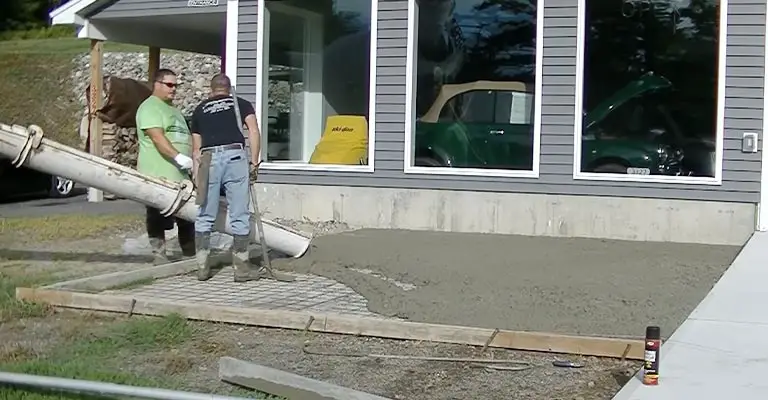There is no problem pouring fresh concrete over existing concrete. Your concrete needs to be in mint condition for this task to be successful.
Make sure that the new mixture is at least two inches thick if you are pouring over an old slab.
Newly poured concrete will not naturally bond to existing slabs due to cement’s lack of natural bonding agents.
It will either be necessary to use a bonding agent or a method of unbonded overlay to adhere the layers together.
Although you can save time and money, if you’re not careful, problems can still arise. Depending on the extent of your existing slab’s problems, you might need to replace it completely.
There are many pros and cons to pouring concrete over an existing concrete slab, and you should consider starting from scratch before pouring concrete over a slab.
Can I Pour Concrete Over Old Concrete?
When properly poured, concrete can be poured over existing concrete. Choosing a solid foundation for your new concrete pour begins with the old concrete. Make sure you’re prepared for potential problems before you start:
Condition-Affected Life Span:
Concrete can last over 50 years if it is properly installed. In contrast, how well the newly poured concrete will hold up depends on how well the existing concrete holds up.
In order to protect your new overlay, it is important to ensure that the initial concrete is in good condition.
Bonding Restrictions:
Sand and aggregates are combined with cement to form concrete. Due to the lack of natural bonding agents in cement, freshly poured concrete will not adhere to the existing slab.
For the two layers to be adhered together, you will need either a bonding agent or an unbonded overlay.
Minimum Required Thickness:
There must be enough thickness in the concrete slab for it to hold up under pressure and weight.
A concrete overlay’s minimum thickness will depend on a number of factors, including its application method and aggregate size.
It will add between 25 and 100 millimeters to the thickness of an existing slab if concrete is added over it.
Can You Add Stamped Concrete Over Existing Concrete?
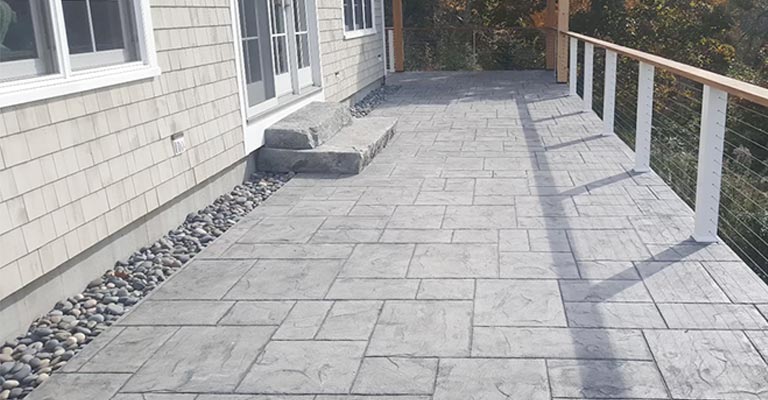
Overlaying existing concrete with stamped concrete is a doable-and very stylish-solution.
During the stamping of concrete, a design is added to the texture of the overlay before it is cured. The designer can add simple or complex designs that imitate bricks and stones based on your preferences and budget.
The installation process for stamped concrete overlays is very similar to pouring concrete over concrete, but it includes adhesives to ensure the concrete is stable during installation.
There is a higher cost associated with stamped concrete than a traditional overlay — between $8 and $28 per square foot. However, many people prefer the look and price of stamped concrete in comparison to traditional pavers.
It is true that stamped concrete can be an alternative to ripping out the concrete, but in order for this process to work, you still need a solid foundation.
To receive a stamped topping, the concrete slab should not be cracked, heaved, sinking, or damaged by tree roots.
Can You Pour Over Concrete With Cracks in It?
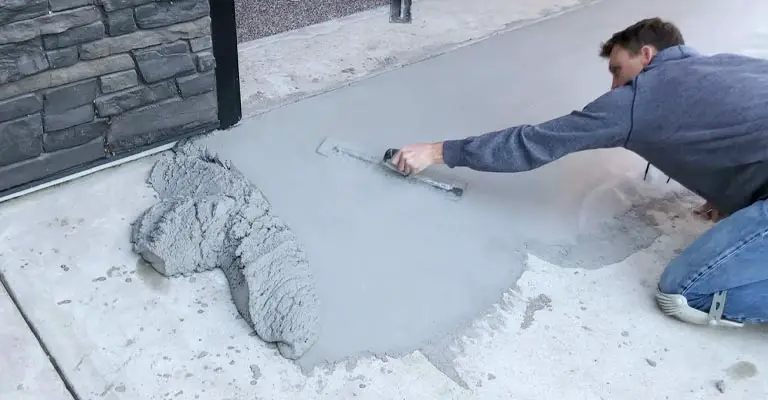
Fresh concrete shouldn’t be poured over old concrete that is severely damaged, such as cracks or crumbles. Concrete slabs are foundations for new layers.
If you pour concrete over cracks, settlements, and other signs of structural damage, these problems will only get worse.
Using masonry filler that adheres to the existing concrete is crucial to repairing concrete cracks. After the concrete has been fully repaired, a clean slate should be prepared before pouring concrete over it.
When Can You Pour Concrete Over Concrete?
It’s vital that you ensure your existing slab is still structurally sound and in good condition before you pour the new concrete. Check the concrete you want to cover for:
- Roots growing underneath the area.
- A crack or buckling caused by frost heaves.
- Signs of settling.
When concrete is in good condition, free from breaks, buckling, or large cracks, it can be used as a foundation for a new layer. Prior to pouring the new concrete, make sure any small cracks are repaired.
In order to patch hairline cracks in the concrete, use a vinyl concrete patching compound and an elastomeric crack filler.
Lastly, the location needs to be able to accommodate the additional height from the new pour.
Any doors that open at the current height should be kept away from the existing slab, as well as areas where an elevation change may cause tripping hazards.
The Benefits Of Pouring Concrete Over Concrete
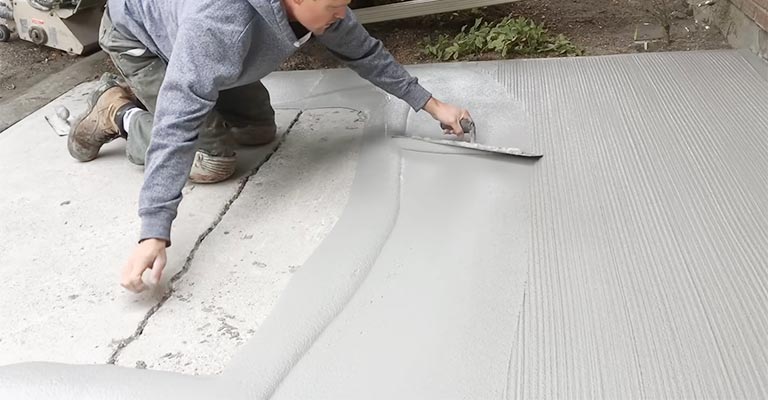
Pouring concrete over concrete is possible, but not always recommended. There are times when it’s beneficial. If you want to pour an entirely new layer of concrete, you are better off removing the old concrete first. Take a look at these pros and cons.
Get A Boost In Appearance
A concrete slab with deep cracks or crumbles may look a little unsightly. If you add another concrete layer on top, you can transform your old, cracked concrete into a brand new looking surface.
Cost-Efficient
You can save money and time by adding a new layer of concrete at your desired thickness. From removing the old concrete layer to installing the new one, concrete costs approximately $120 per cubic yard.
Concrete can be poured over the existing concrete layer, which saves you from removing the old concrete and its disposal costs.
Time-Saving
The process of breaking up concrete is a time-consuming home improvement job that requires a great deal of effort.
Most homeowners prefer just to add a fresh layer on top rather than removing old concrete, clearing off the area, and placing a new load. The time commitment and hard work involved are reasons for this.
Cons of Pouring Concrete Over Concrete
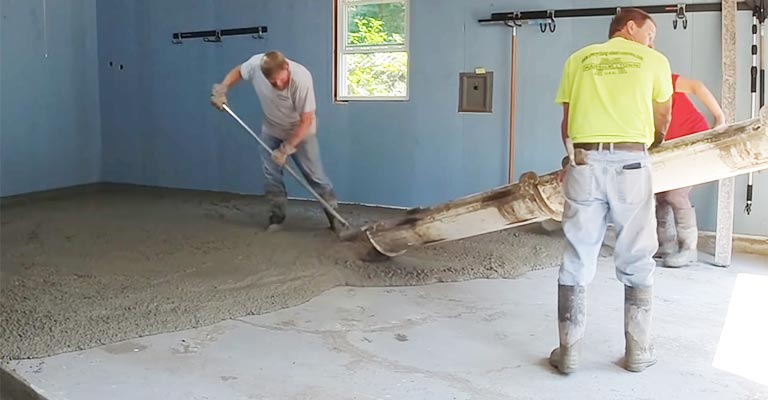
There is no point in sweeping all concrete problems under the rug with a new layer of metaphorical carpet. Whether concrete is poured over concrete or not can create issues immediately or years later.
More Cracking
There are a number of problems underneath your concrete slab that can cause large cracks in its surface, including improper leveling and root intrusion.
The top layer will only cover the cracks briefly before the bottom layer starts cracking, particularly if your two layers bond together.
Increases Height
Your slab’s overall level will be raised by adding a concrete layer to the one you already have. Some homeowners might not be concerned about height.
The added layer could, for instance, create a tripping hazard or prevent exterior doors from opening properly. It is also possible for the concrete to sink, so tossing off the level of the original structure below.
Decrease Life Span
Under the right conditions, concrete can last as long as 100 years. Concrete will not last nearly as long if you pour a new layer over an older one.
Because the older concrete layer under the top layer shows signs of aging more quickly. As a result of this inconsistent aging, you will need to replace your entire slab earlier than expected (or wanted).
Alternatives to Pouring Concrete Over Old Concrete
You should examine the other options available in the industry before adding a fresh layer of concrete over existing concrete. All three options have pros and cons, but repairs, replacements, and resurfacing are your best bets.
Concrete Replacement
Take, for instance, tearing up the old concrete and starting from scratch. Keep in mind a few costs if you go this route. An average of $2 to $6 per square foot is charged for demolishing and removing old concrete.
In addition to additional drainage or design costs, the cost of laying a new concrete slab increases from $4 to $8 per square foot.
Concrete Resurfacing
The process of pouring concrete over concrete is very similar to concrete resurfacing, but the construction method is slightly different.
The surface will be leveled out by adding a thin layer of concrete over top or in combination with a bonding agent after the concrete slab is in good condition.
Just as you would with a fresh layer of concrete, the end result is a flat, smooth overlay that can be stained, stamped, or polished.
Concrete Repairs
When you hire a professional, cracks, holes, and concrete spalling can all be fixed, but it depends on whether you think it’s worth it.
For example, repairing a crack in a concrete driveway can cost as much as $1 to $25 per square foot, depending on its extent.
Consider comparing prices with a local concrete driveway pro if you are unsure whether to repair or replace.
How to Properly Pour Concrete Over Concrete
Here’s a rough guide on how to properly pour concrete over concrete, now that you know if it’s possible for your slab:
Step 1: Make sure your existing slab is clean and free of dirt, debris, dust, and any other particles that may prevent the new slab from adhering properly.
Step 2: Set up a perimeter with string and stakes.
Step 3: Attach the base with rebar or fiber mesh.
Step 4: Choose whether to bond your concrete. Prime your existing layer if necessary. Alternatively, tar paper or sand can be used to break the bond if it is not possible.
Step 5: Overlay the existing layer with concrete (or self-leveling concrete).
Step 6: Carefully level and smooth the concrete if using traditional concrete, and allow it to cure.
Pouring Concrete Over Concrete vs. Replacing
It’s not impossible to pour concrete over an existing layer, but it’s not foolproof either. You must first fix any foundational concrete problems in order to ensure your new concrete slab will last.
With your new slab, you’ll face the same problems. It’s better to remove and replace the existing slab if the damage is extensive and you can’t save the first slab without damaging the new layer. This will save you time and hassle in the future.
The benefits of pouring concrete over concrete are short-term, but they aren’t worth it if you’ll have to remove both layers within a few years (or months).
In the event your concrete slab needs to be replaced, contact a concrete repair company.
When Should You Repair or Replace the Current Concrete?
Concrete that has been repaired or replaced may be better than concrete that has been covered.
As the original slab deteriorates, the new concrete layer will also suffer from serious structural problems, so both must be replaced.
Repairing or replacing your concrete can save you time and money in the following situations:
A new layer would present an obstacle: A new layer would make it impossible to open a door or present a tripping hazard.
Roots grow underneath: Root growth can cause the concrete to lift and move, causing instability.
The concrete is cracked or pitted: These problems can delay the installation of new overlays, but they can be remedied by repairing and resurfacing the existing concrete.
The concrete is deteriorating: When concrete breaks apart under cleaning, it cannot be repaired and must be replaced.
The surface is uneven: Even though you can level concrete by adding another layer, grinding it down may be more cost-effective.
The slab is sinking: Improperly installed subbases usually result in sinking concrete. To resolve this issue, you’ll need to replace the concrete.
What Chemicals Are Used To Bond Old Concrete To New Concrete?
For bonding old concrete to new concrete, you’ll discover a mixture of natural and synthetic polymers, rubbers, epoxies, and resins.
Whether you’re adhering concrete over concrete, concrete over sand or concrete over gravel, the best bonding agent depends on your concrete pouring method. Bonding chemicals are also included in some concrete resurfacing mixtures.
Will Wet Concrete Bond To Dry Concrete?
It is not possible for wet concrete to bond to dry concrete without the addition of a bonding agent. Under a concrete slab, sand or gravel is commonly added to enhance bonding and create a stable foundation.
There are several factors to consider when choosing the right concrete slab, including the slab thickness, the slab height, and local laws.
How Thick Should You Pour Concrete Over Existing Concrete?
A minimum thickness of 2 inches is necessary for concrete to maintain its quality and stability. It is best to make the new slab not too heavy or too high, since most concrete slabs are between 4 and 6 inches thick.
You should hire a stamped concrete contractor to determine the appropriate concrete thickness when you are considering a stamped concrete overlay.

